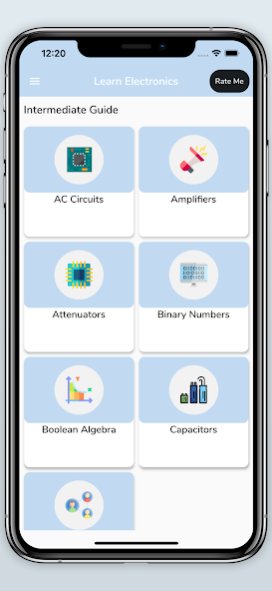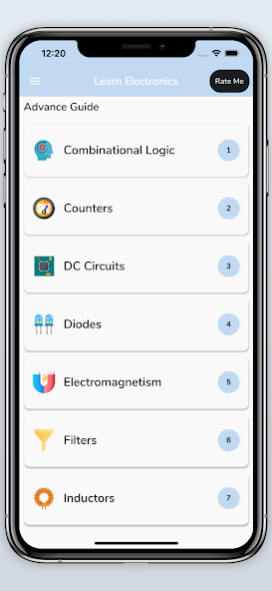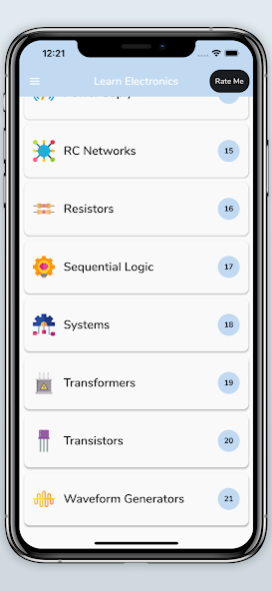Learn Basic Electronics - Beg 2.2
Free Version
Publisher Description
Learn Basic Electronics - Beginner To Advance. The motion of electrons through a conductor gives us electric current. This electric current can be produced with the help of batteries and generators.
Electronic circuits are everywhere, from computers and smartphones, to home appliances and cars. Think of all the everyday objects that are becoming “smart”... in the future, most of the things that we own will contain some electronics. Jobs in electronics are in high demand and well paid in almost every country!
Building electronic products is incredibly rewarding, whether you do it professionally or just as a hobby. There is just something different and exciting about designing something physical that can be hold in one’s hand and that interacts with the outside world, and today it has become incredibly easy to get started thanks to cheap development boards such as the Arduino and Raspberry Pi, combined with the right knowledge.
Differently than what happens in other disciplines, knowledge of Electronics does not become obsolete, but it is always current as it is intimately connected to physics and to the fundamental laws of nature. Hence, while new components and chips might come along every year, the fundamental principles of Electronics always stay the same.
Electronics comprises the physics, engineering, technology and applications that deal with the emission, flow and control of electrons in vacuum and matter. It uses active devices to control electron flow by amplification and rectification, which distinguishes it from classical electrical engineering which uses passive effects such as resistance, capacitance and inductance to control current flow.
Electronics has had a major effect on the development of modern society. The identification of the electron in 1897, along with the subsequent invention of the vacuum tube which could amplify and rectify small electrical signals, inaugurated the field of electronics and the electron age.
This distinction started around 1906 with the invention by Lee De Forest of the triode, which made electrical amplification of weak radio signals and audio signals possible with a non-mechanical device. Until 1950, this field was called "radio technology" because its principal application was the design and theory of radio transmitters, receivers, and vacuum tubes.
Analog Circuits
Most analog electronic appliances, such as radio receivers, are constructed from combinations of a few types of basic circuits. Analog circuits use a continuous range of voltage or current as opposed to discrete levels as in digital circuits.
The number of different analog circuits so far devised is huge, especially because a 'circuit' can be defined as anything from a single component, to systems containing thousands of components.
Analog circuits are sometimes called linear circuits although many non-linear effects are used in analog circuits such as mixers, modulators, etc. Good examples of analog circuits include vacuum tube and transistor amplifiers, operational amplifiers and oscillators.
Digital Circuits
Digital circuits are electric circuits based on a number of discrete voltage levels. Digital circuits are the most common physical representation of Boolean algebra, and are the basis of all digital computers.
To most engineers, the terms "digital circuit", "digital system" and "logic" are interchangeable in the context of digital circuits. Most digital circuits use a binary system with two voltage levels labeled "0" and "1". Often logic "0" will be a lower voltage and referred to as "Low" while logic "1" is referred to as "High".
However, some systems use the reverse definition ("0" is "High") or are current based. Quite often the logic designer may reverse these definitions from one circuit to the next as he sees fit to facilitate his design. The definition of the levels as "0" or "1" is arbitrary.
About Learn Basic Electronics - Beg
Learn Basic Electronics - Beg is a free app for Android published in the Teaching & Training Tools list of apps, part of Education.
The company that develops Learn Basic Electronics - Beg is Foobr Digital. The latest version released by its developer is 2.2.
To install Learn Basic Electronics - Beg on your Android device, just click the green Continue To App button above to start the installation process. The app is listed on our website since 2021-10-27 and was downloaded 0 times. We have already checked if the download link is safe, however for your own protection we recommend that you scan the downloaded app with your antivirus. Your antivirus may detect the Learn Basic Electronics - Beg as malware as malware if the download link to com.appsfactory.basicelectronic is broken.
How to install Learn Basic Electronics - Beg on your Android device:
- Click on the Continue To App button on our website. This will redirect you to Google Play.
- Once the Learn Basic Electronics - Beg is shown in the Google Play listing of your Android device, you can start its download and installation. Tap on the Install button located below the search bar and to the right of the app icon.
- A pop-up window with the permissions required by Learn Basic Electronics - Beg will be shown. Click on Accept to continue the process.
- Learn Basic Electronics - Beg will be downloaded onto your device, displaying a progress. Once the download completes, the installation will start and you'll get a notification after the installation is finished.



